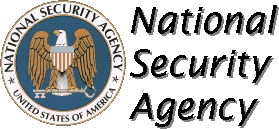
Pretorian's backdoor
Saviez vous ce que vous faisiez en cliquant sur cette image?
Si vous avez vu le film "Traque sur Internet"" vous vous souvenez peut-être que l'héroïne, Angela, ( dont le rôle est tenu par Sandra Bulock ) découvre, en débuguant un logiciel tout à fait bénin, ce que l'on appelle une "trappe" en langage informatique, autrement dit, un ligne de commande introduite dans un programme permettant à n'importe quelle personne connaissant le mot de passe de la trappe de s'infiltrer dans le système où a été installé le programme.
Malheureusement pour vous, cette fausse backdoor ne vous mènera pas très loin. Cependant, pour satisfaire votre curiosité, voici un document officiel résumant l'historique et le fonctionnement de la très discrète mais très active N.S.A., Agence de Sécurité Nationale américaine :

NSA - National Security Agency
U.S. Signals Espionage Agency (1952 - )
Established in 1952 by President Harry Truman, the NSA is the most secret of American intelligence agencies and it seldom makes an appearance in the media. Its chief function is deciphering messages sent through all forms of sophisticated communications. The NSA was formed to unify all of the U.S. cryptographic agencies existing in the armed services, as well as those in the intelligence services and diplomatic corps.
The three armed services, the FBI, and the CIA all contribute and share in the efforts of the NSA, which was originally headquartered in Fort Meade, Maryland. This ultra-secret organization employs a vast army (approaching 100,000 at last count) of computer experts, satellite and electronic technicians, programmers, and analysts, and, for the most part, cryptographers who brilliantly decipher the codes of foreign powers.
Housed within the Defense Department, the NSA's director reports to an Assistant Secretary of Defense who, in turn, reports to the Secretary of Defense. The Secretary of Defense is a member of the National Security Council (NSC), which he briefs. The Council in turn, answers to the President.
In addition to deciphering and decoding, the NSA operates a vast worldwide electronic eavesdropping network through armed forces and intelligence agencies. Throughout the free world and inside Communist countries and other nations ruled by dictatorships, the NSA has operatives monitoring military and diplomatic networks, copying coded messages that are then transmitted back to the NSA for decoding or deciphering. The messages of friends and foes alike are monitored, deciphered, and analyzed.
Prosaic written and telephoned messages are taken into the agency, as well as all forms of electronic messages. NSA's four code-breaking departments handle commercial, military, and diplomatic messages as well as those sent by individuals who, for whatever reason, may be under electronic surveillance. Special sections are dedicated to sophisticated types of electronic espionage--Elint handles electronics intelligence, Radint covers radar intelligence. Comint is an NSA term that applies to all communications intelligence.
Only three serious breaches of security in NSA history have occurred. The first involved Jack Edward Dunlap, a sergeant who functioned as a chauffeur, and who managed to sell secrets to the Soviets before committing suicide in 1958. The second involved William H. Martin and Bernon F. Mitchell, two homosexual cryptographers who defected to Soviet Russia in 1960, causing the agency to completely overhaul its organization and institute a rigid internal security force, the Office of communications Security.
The third breach of security that damaged the NSA came from an indirect source, James William Hall III. A native of Sharon Springs, N.Y., Hall following his high school graduation, joined the army at eighteen in 1976. He was trained as an analyst of intercepted encrypted radio and telephone traffic culled in the field by ASA (Army Security Agency) operatives, information which is funneled to NSA through Army G-2. In 1977, Hall was given a top secret clearance.
Hall rose to the rank of warrant officer and, from January 1981 to January 1985, he was stationed in West Berlin as a senior analyst of electronic communications for Army G-2, deciphering coded messages sent by Soviet diplomatic and military nets. He lived off base with his wife and two children and, in 1982, he began selling the KGB information on COMINT (U.S. Communications Intelligence), collecting an estimated $100,000 to $200,000 from his Soviet spymasters. For this money, Hall delivered detailed data on the army's most up-to-date equipment and methods in electronic eavesdropping.
Undetected, Hall returned to the U.S. in May 1987, stationed at Fort Huachuca, Arizona, before being sent to Fort Stewart, Georgia, where he went on selling secrets to his Soviet control, Huseyin Yildirin. From January to July 1988, Yildirin reportedly paid $40,000 to Hall for stolen COMINT secrets. Hall then began spending money, buying a new house and car. His spendthrift ways alerted superiors and, subsequently the FBI.
On December 20, 1988, an undercover FBI agent, posing as a KGB spymaster, paid Hall $30,000 for secrets he stole at Fort Stewart. Hall was then arrested as was Yildirin. Hall was sent to prison for forty years and fined $50,000 and Yildirin was also imprisoned. The damage, however, had already been done with the KGB acquiring information on the most sophisticated electronic surveillance used by the ASA/NSA, almost all of which had to be altered and reconstructed at a staggering cost.
The NSA, unlike the CIA, invariably has a high-ranking military man as its director. Typical was Lieutenant-General Lincoln D. Faurer, a U.S. Air Force officer who became the NSA chief in 1981. Faurer had Served as chief of intelligence of the U.S. European command in Germany and had been deputy chairman of the NATO military committee in Brussels.
The NSA's budget is certainly much larger than that of the CIA or the FBI combined. Its operations are so vast and its staff so large that only the President and the National Security Council (NSC) know how many billions the agency spends each year. A similar but considerably scaled-down version of NSA exists in England, the Government Communications Headquarters in Cheltenham, with which the NSA works closely.